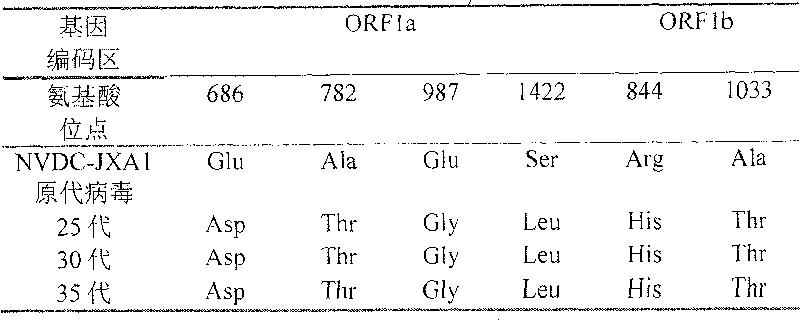Low virulent strain of porcine reproductive and respiratory syndrome virus, immunogenicity immunogenicity material and vaccine
A technology for respiratory syndrome and pig reproduction. It is applied in the directions of virus antigen components, antiviral agents, viruses/phages, etc. It can solve the problems that the immune efficacy needs to be improved, the pigs cannot be directly vaccinated, and the protection effect is different.
- Summary
- Abstract
- Description
- Claims
- Application Information
AI Technical Summary
Problems solved by technology
Method used
Image
Examples
Embodiment 1
[0050] Virus Subculture and Identification Test
[0051] Porcine reproductive and respiratory syndrome virus NVDC JXA1-R attenuated strain (virus content 10 5.0 TCID 50 / ml above), Marc-145 cell line, all provided by the Veterinary Diagnosis Office of China Animal Disease Prevention and Control Center.
[0052] Take well-grown MARC-145 cells, digest them with trypsin, inoculate them in cell flasks, pour out the growth medium after growing into a single layer, replace them with cell maintenance medium containing 5% virus seeds, and culture them at 37°C for 2-3 days. On the first day, when 70% of the cells had lesions, they were harvested, frozen and thawed twice at -40°C, centrifuged, subpackaged, and then identified.
[0053] Using the RT-PCR method, the genome of the attenuated NVDC JXA1-R strain was amplified in segments (different generations of cultures were amplified separately). The obtained gene amplification product is recovered, purified, connected to a sequencing ...
Embodiment 2
[0073] Pathogenicity determination and immunogenicity test of different generations of viruses
[0074] Experimental animals: A total of 30 dual or triple hybrid pigs aged 4 to 6 weeks were taken, and both the antigens detected by PRRS virus RT-PCR kit and the antibodies detected by ELISA were negative. They were randomly divided into 5 pigs / group and raised separately.
[0075] Pathogenicity determination: Inoculate a group of pigs (5 pigs) with 25th, 49th, 60th, and 80th generation PRRS virus JXA1-R strain cultures, and inject 2 mL intramuscularly into each head. The remaining 5 pigs (unvaccinated) served as the control group. The clinical manifestations of pigs were observed and recorded daily until 28 days after inoculation.
[0076] Immunogenicity test: on the 28th day after immunization, a total of 20 pigs inoculated with the PRRS virus JXA1-R strain, and 5 pigs (not inoculated) in the control group were all tested with virulent ( PRRS virus NVDC-JXA1 strain 5th gener...
Embodiment 3
[0083] Pathogenicity determination and immunogenicity test of mixed viruses of different generations
[0084] Experimental animals: A total of 40 dual or triple hybrid pigs aged 4 to 6 weeks were taken, and both the antigens detected by the PRRS virus RT-PCR kit and the antibodies detected by ELISA were negative. They were randomly divided into 5 pigs / group and raised separately.
[0085] Pathogenicity determination: PRRS with 25+49 generations, 25+65 generations, 25+80 generations, 49+80 generations, 49+60 generations, 60+80 generations, 25+49+60+80 generations mixed in equal proportions The culture of the virus JXA1-R strain was inoculated into a group of pigs (5 pigs), and each head was injected intramuscularly with 2 mL. The remaining 5 pigs (unvaccinated) served as the control group. The clinical manifestations of pigs were observed and recorded daily until 28 days after inoculation.
[0086] Immunogenicity test: on the 28th day after immunization, a total of 35 pigs i...
PUM
 Login to View More
Login to View More Abstract
Description
Claims
Application Information
 Login to View More
Login to View More - R&D
- Intellectual Property
- Life Sciences
- Materials
- Tech Scout
- Unparalleled Data Quality
- Higher Quality Content
- 60% Fewer Hallucinations
Browse by: Latest US Patents, China's latest patents, Technical Efficacy Thesaurus, Application Domain, Technology Topic, Popular Technical Reports.
© 2025 PatSnap. All rights reserved.Legal|Privacy policy|Modern Slavery Act Transparency Statement|Sitemap|About US| Contact US: help@patsnap.com



